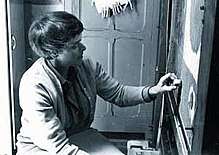Claire Parker
Claire Parker (August 31, 1906 – October 3, 1981) was an American engineer and animator. A graduate of MIT, her best-known contribution to the history of cinema is the Pinscreen (Écran d'épingles), a vertically-mounted grid of 240,000 sliding metal rods that are first manually pushed into position to create lit and shaded areas, then filmed frame by frame.[1] While the hand-operated, mechanical Pinscreen superficially shares characteristics with early optical toys like the zoetrope, it is distinguished by being one of the first devices ever to produce animation by reconfiguring a set of individual picture elements, later called pixels. Its pin "resolution" is sufficient to create photorealistic images, a painstaking process analogous to modern pixel art.
Claire Parker | |
|---|---|
 Parker at the pinscreen | |
| Born | August 30, 1906 |
| Died | October 3, 1981 (aged 75) |
| Nationality | American |
| Education | Massachusetts Institute of Technology |
| Known for | Engineering, Animation |
| Spouse(s) | Alexandre Alexeieff ( m. after 1940) |
Parker shared directing credits for her films with her husband and collaborator, Russian animator Alexandre Alexeieff; however, the 1935 patent on the Pinscreen was made in her name alone.[2] Alexeieff and Parker's Pinscreen films include Night on Bald Mountain (1933) and The Nose (1963), as well as the opening title sequence for Orson Welles' film The Trial (1962). As of 2012, the last known original Pinscreen still being used in animation production is maintained at the National Film Board of Canada's main campus in Montreal.[3]
Further reading
References
- Furniss, Maureen (December 1998). Art in Motion: Animation Aesthetics. Indiana University Press. pp. 54–57. ISBN 978-1-86462-039-9. Retrieved 17 February 2012.
- French Animation History - Richard Neupert - Google Books
- Blair, Iain (June 4, 2012). "NFB pushes Canadian artists in edgy direction". Variety. Retrieved June 5, 2012.